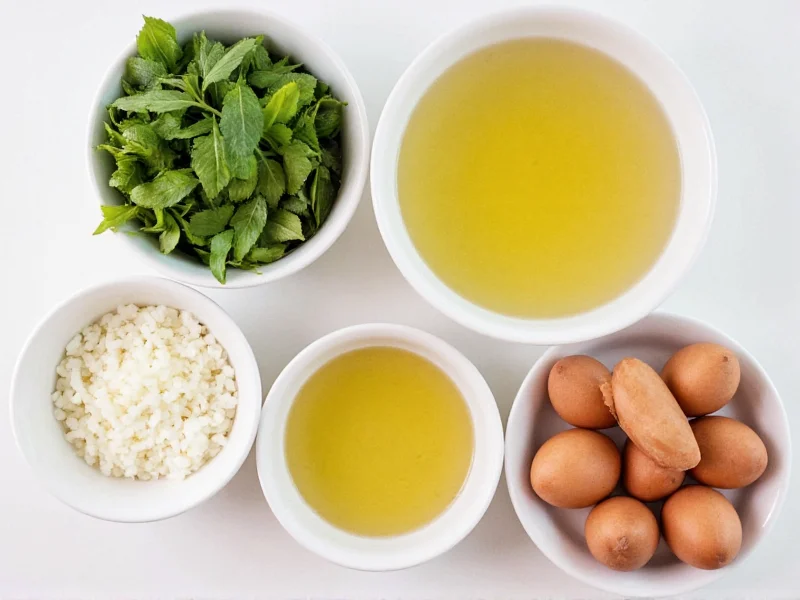Egg drop soup, a staple of Chinese-American cuisine, delivers comforting warmth with minimal ingredients. Understanding each component's role transforms this simple dish from bland to extraordinary. This guide details not just what to include, but why each ingredient matters for authentic results.
Core Egg Drop Soup Ingredients Explained
Chicken Broth or Stock
The foundation of any quality egg drop soup starts with flavorful broth. While store-bought low-sodium chicken broth works well for quick egg drop soup ingredients preparation, homemade stock provides superior depth. The broth's quality directly impacts the final dish—cloudy or overly salty bases ruin the delicate balance. For vegetarian versions, mushroom or vegetable broth makes an excellent substitute without compromising texture.
Eggs
Fresh, high-quality eggs create the signature ribbons that define this soup. The proteins in eggs coagulate when added to hot broth, forming delicate strands. Room-temperature eggs incorporate more smoothly than cold ones, preventing premature curdling. For the best traditional egg drop soup ingredients ratio, use 1-2 eggs per 4 cups of broth depending on desired richness.
Cornstarch Slurry
This thickening agent gives egg drop soup its characteristic silky body. The standard authentic Chinese egg drop soup recipe ingredients call for a simple slurry of 1 tablespoon cornstarch mixed with 2 tablespoons cold water per 4 cups broth. Too little creates a watery soup; too much yields an unappetizingly gloppy texture. Arrowroot makes an effective gluten-free alternative with similar results.
Soy Sauce
While traditional versions use light soy sauce for subtle seasoning, some modern recipes incorporate a touch of dark soy for color. The essential egg drop soup seasonings should enhance rather than overpower—start with 1 teaspoon per 4 cups broth and adjust to taste. Tamari works well for gluten-free requirements while maintaining umami depth.
| Core Ingredient | Standard Amount (per 4 cups broth) | Key Function |
|---|---|---|
| Chicken broth | 4 cups | Flavor foundation |
| Eggs | 1-2 large | Signature ribbons |
| Cornstarch | 1 tbsp | Texture thickening |
| Soy sauce | 1 tsp | Umami seasoning |
| Green onions | 2 tbsp chopped | Color and freshness |
Supporting Ingredients for Enhanced Flavor
Fresh Ginger
A 1-inch piece of ginger, sliced thin or grated, adds aromatic complexity without heat. Simmered in the broth before adding other ingredients, it infuses subtle warmth. For simple egg drop soup ingredient list purists, this represents the only "spice" in authentic preparations.
Green Onions
Added at the end for color contrast and fresh flavor, these provide visual appeal and aromatic finish. The white parts can simmer with the ginger for deeper flavor, while green sections garnish the finished soup. Chives make an acceptable substitute when unavailable.
Sesame Oil
Just 1/2 teaspoon per serving added at the end elevates the dish with nutty aroma. This finishing touch represents the secret ingredient in restaurant-style egg drop soup that home cooks often overlook. Toasted sesame oil delivers more intense flavor than regular varieties.
Variations and Substitutions
While traditional egg drop soup maintains remarkable simplicity, regional variations exist. Some Cantonese versions include a pinch of white pepper, while American-Chinese restaurants sometimes add beaten egg whites for extra silkiness. For healthy egg drop soup ingredients modifications, reduce sodium by using low-sodium broth and limiting soy sauce.
Dietary adaptations work well with this flexible recipe. Vegan versions replace chicken broth with mushroom stock and omit eggs, using blended silken tofu for similar texture. Gluten-free preparations simply ensure soy sauce substitution with tamari.
Ingredient Quality Matters
The minimalist nature of egg drop soup means each component must shine. Fresh eggs produce smoother ribbons than older ones. Low-sodium broth allows better seasoning control. Organic soy sauce often contains fewer additives that could cloud the broth. When preparing authentic egg drop soup ingredients list dishes, quality trumps quantity every time.
Frequently Asked Questions
What are the essential ingredients for traditional egg drop soup?
The essential ingredients are chicken broth, eggs, cornstarch, soy sauce, green onions, ginger, and sesame oil. These seven components create the classic texture and flavor profile that defines authentic egg drop soup.
Can I make egg drop soup without cornstarch?
Yes, though the texture will differ. Cornstarch creates the signature silky body, but you can omit it for a clearer broth. The soup will be thinner but still flavorful. Some traditional Chinese versions use minimal or no thickener for a more delicate result.
What's the secret to perfect egg ribbons in egg drop soup?
The key is slowly drizzling room-temperature beaten eggs into gently simmering broth while stirring in one direction. High heat causes scrambling rather than ribbon formation. Using a ladle to create a vortex in the broth helps distribute the eggs evenly for fine, delicate strands.
Are there vegetarian egg drop soup ingredient alternatives?
Absolutely. Substitute chicken broth with mushroom or vegetable broth, and consider adding a tablespoon of nutritional yeast for umami depth. The eggs remain the same, but some vegan versions use blended silken tofu to mimic the egg ribbon texture while maintaining plant-based ingredients.
How can I enhance store-bought broth for better egg drop soup?
Simmer store-bought broth with fresh ginger slices, green onion whites, and a small piece of kombu for 15-20 minutes before making the soup. Strain before proceeding with the recipe. This simple step adds depth that mimics homemade stock, significantly improving the final dish's flavor profile.











 浙公网安备
33010002000092号
浙公网安备
33010002000092号 浙B2-20120091-4
浙B2-20120091-4